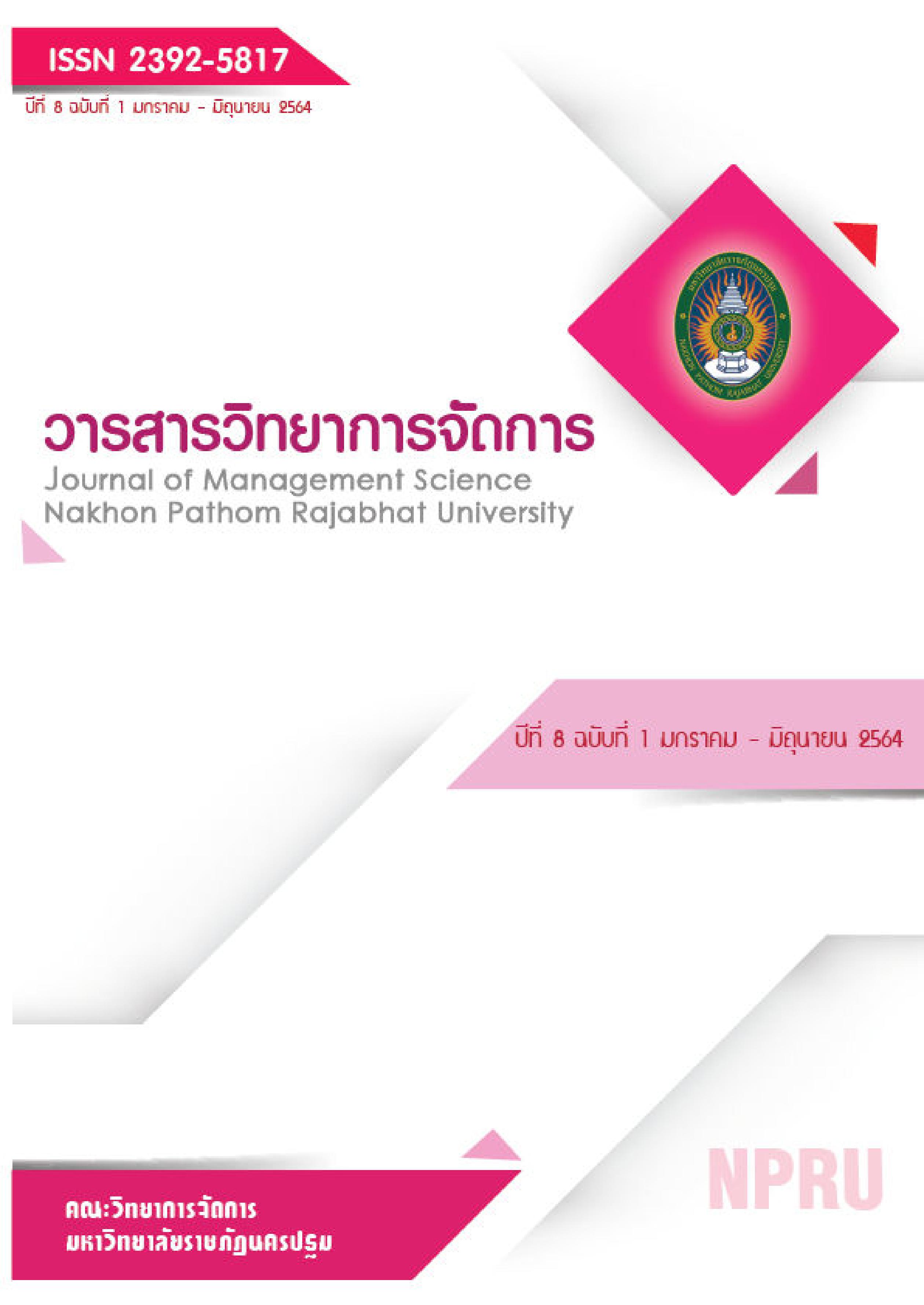The Consumers Behavior In Buying Jewelry In Muang District of Kanchanaburi Province
Main Article Content
Abstract
This research aims to study (1) consumer behavior in buying jewelry and (2) The relationship between personal factors and consumer behavior in purchasing jewelry in amphoe maung, Kanchanaburi province. The population was the consumer who chose to buy jewelry in amphoe maung, Kanchanaburi province which did not know the exact population. A sample size of 400 was obtained from the purposive selection method. The research tool was a questionnaire. The data collected were analyzed for statistics regardless of the population distribution, frequency distribution, percentage and chi-square statistics were used.
The results showed that:
1. Consumer behavior in buying jewelry found that most samples purchased ring jewelry and purchased it on average once a year. The decided amount is less than 5,000 baht. Buy gemstones made of platinum and made from precious gemstones that are solid. Buy at diamond gold jewelry general stores and buy them from reputable/reliable stores during weekends (Sat-Sun). The criteria used to make a purchase are the right price for the quality, receive information about jewelry from word of mouth but there was no effect in making a purchase decision. Planning before making a purchase
2. The relation factors between personal factors and jewelry purchase behavior (2.1) gender correlated with the choice of jewelry, the average number of purchases, reasons for buying and the criteria used in making purchasing decisions (2.2) age correlated with the choice of jewelry, times of purchase, reasons for purchase and characteristics of the store, purchase decision criteria and plan to purchase. (2.3) the status correlated with the influencer person and plan to purchase (2.4)education level correlated with influencer person, characteristics of the store, the resources obtained to influence the purchase of jewelry. (2.5) occupation correlated with the choice of jewelry, the average number of purchases, reasons for buying, purchase decision criteria and plan to purchase. (2.6) Income correlated with the choice of jewelry, the average number of purchases, reasons for buying and plan to purchase. Statistically significant correlations level at .05 and .01
Article history: Received 2 February 2021
Revised 14 April 2021
Accepted 16 April 2021
SIMILARITY INDEX = 1.35 %
Article Details
The views and opinions of the article appearing in this journal are those of the author. It is not considered a view and responsibility of the editorial staff.
References
บุญกิต จิตรงามปลั่ง. (2561). การพัฒนานโยบายเพื่อให้ประเทศไทยเป็นศูนย์กลางการผลิตและการค้าอัญมณีและเครื่องประดับของโลก. วารสารสถาบันวิชาการป้องกันประเทศ, 9 (3) : 88-98.
ภัทรพิมพ์ พิมพ์ภัทรยศ. (2551). พฤติกรรมผู้บริโภคสินค้าเครื่องประดับอัญมณี ในอำเภอเมือง จังหวัดเชียงใหม่. บริหารธุรกิจมหาบัณฑิต สาขาวิชาการบริหารธุรกิจ, บัณฑิตวิทยาลัย, มหาวิทยาลัยเชียงใหม่.
ศูนย์ข้อมูลอัญมณีและเครื่องประดับ สถาบันวิจัยและพัฒนาอัญมณีและเครื่องประดับแห่งชาติ (องค์การมหาชน). (2560). มูลค่าการส่งออกอัญมณีและเครื่องประดับไทยระหว่างปี 2558-2559 [ออนไลน์] ค้นเมื่อ 19 มกราคม 2561 จาก https://thaitextile.org/th/insign/detail.460.1.0.html.
เสาวนีย์ สมันต์ตรีพร. (2562). ความต้องการผลิตภัณฑ์เครื่องประดับอัญมณีของชาวไทยและชาวต่างชาติ. วารสารบัณฑิตศึกษา มหาวิทยาลัยราชภัฏเชียงราย, 12 (2) : 43-51.
Assael, H. (1998). Consumer behavior and marketing action. Cincinnati, Ohio : South-Western College Pub., c1998.
Bogomolova, S., Vorobyev, K., Page, B., and Bogomolov, T. (2016). Socio-demographic differences in supermarket shopper efficiency. Australasian Marketing Journal (AMJ), 24(2), 108-115. doi:https://doi.org/10.1016/j.ausmj.2016.01.002
Cochran,W.G. (1953). Statistical Problems of the Kinsey Report. Journal of the American Statistical Association, 48(264), 673-716. doi:10.1080/01621459.1953.10501194
Kotler.P. (1994). Reconceptualizing marketing: An interview with Philip Kotler. European Management Journal, 12(4),353-361. doi:https://doi.org/10.1016/0263-2373(94)90021-3
Kotler, P. and Armstrong, G. (1997). Marketing: An Introduction. (4th ed.). Englewood Cliffs, NJ: Pearson Education.
Kotler, P. and Gary, A. (1996). Principles of Marketing. (7th ed.). NJ: Englewood Cliffs, NJ: Pearson Education.
María, V., Sebastian, M., and Francisco, M.-L. (2017). Segmentation and explanation of smartphone use for travel planning based on socio-demographic and behavioral variables. Industrial Management and Data Systems, 117 (3), 605-619. doi:10.1108/imds-03-2016-0089
Peighambari, K., Sattari, S., Kordestani, A., and Oghazi, P. (2016). Consumer Behavior Research. SAGE Open, 6(2), 2158244016645638. doi:10.1177/2158244016645638


